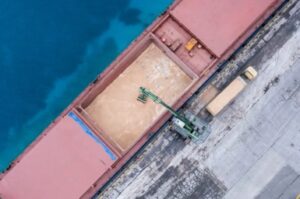
Gard P&I Club has provided key recommendations to mitigating accidents during fumigation operations, especially while in transit. Fumigation of cargo holds using aluminium phosphide tablets, which release phosphine gas, is essential to protect products from infestation and ensure they arrive in good condition. The heavier-than-air phosphine gas penetrates the cargo to eliminate insects and pests.
However, according to Gard, despite the existence of industry best practice recommendations, fumigation-related incidents continue to occur. While it remains uncertain how many fatalities could have been prevented through stricter adherence to the current IMO guidance, many incidents have been linked to the absence of vessel-specific procedures, underestimation or lack of awareness of the risks involved, or decisions influenced by commercial pressures.
The IMO best practice recommendations clearly assign primary responsibility for the fumigation process to the designated fumigator-in charge. However, the vessel operator and master remain responsible for ensuring safe working conditions onboard. Therefore, when fumigation is planned – especially if treatment will continue during the voyage – the precautions outlined in MSC.1/Circ.1264 should be reviewed and used as a basis for establishing appropriate vessel-specific safety protocols within the Safety Management System (SMS).
A checklist can be prepared using Appendix 3 of the IMO circular, Model Checklist for In-Transit Fumigation, or by referring to the Fumigation Checklist found in the Fumigation Handbook published by the United States Department of Agriculture (USDA).
In addition, the following measures should be considered, Gard Club highlights:
– Conduct or reaffirm risk assessments, ensuring that all hazards associated with fumigated cargoes, including toxic exposure, oxygen depletion, fire, and explosion risks, are identified, addressed, and managed throughout the voyage.
– Ensure vessel-specific enclosed space registers and entry procedures clearly recognise the presence of dangerous fumigant gases as an added risk – both for cargo holds and for spaces connected to or adjacent to fumigated holds.
– Provide comprehensive general-level training to all crew members. In addition, when in-transit fumigation is planned, the fumigator-in-charge should brief all crew members directly on fumigation hazards, symptoms of exposure, and emergency actions – rather than delegating this responsibility solely to the designated vessel representatives. Ensure full attendance and understanding during safety briefings.
– Verify that emergency procedures are in place to deal with crew exposure to fumigant gases. The US CDC’s emergency response card on phosphine provides useful information. Medical officers could also consult the emergency section of the Mariners Medico Guide for up-to-date guidance on treating patients exposed to poisonous gases.
– Require thorough pre-loading gas-tightness inspections by the fumigator-in-charge, with documented results. Where gas-tightness cannot be determined with certainty, implement additional risk control measures, such as supplementary gas monitoring. After fumigant application and before disembarkation, require the fumigator-in-charge to inspect and confirm that no gas leaks are present and to formally attest that conditions onboard are safe.
– Emphasise the designated vessel representatives’ responsibility to participate in both pre-loading and post-fumigation inspections. This promotes crew awareness and familiarity with vessel conditions and potential risk areas. However, avoid placing responsibility on the master or their representatives to sign-off for gas-tightness and safe conditions, as this may create a conflict of interest.
– Implement procedures to minimise crew time spent on deck and near hatch covers during the first 24 to 36 hours after fumigation has been set – when the risk of fumigant gas explosions is highest.
– Equip vessels with reliable portable atmosphere testing instruments, fitted with sensors capable of detecting fumigant gases such as phosphine, and increase the frequency of gas checks.
– Arrange for continuous atmosphere monitoring in high-risk areas, such as spaces connected to or adjacent to fumigated cargo holds, especially if those spaces are designed for continuous occupation or are frequently accessed.
– Assess the impact of modifying or interrupting ventilation system airflow during the voyage, as such changes may increase the risk of hazardous conditions.
– Reinforce that crew should never handle fumigants. If top-up fumigation is required during the voyage (e.g. for log cargoes), request the fumigator-in-charge to sail with the vessel.
– Establish a clear company policy on the use of adequate respiratory protection for personnel that enter holds where fumigants have been present – acknowledging that hazards may persist even after a hold is certified gas free and spent fumigants have been removed, and warning crew and port workers to remain vigilant and use appropriate protective equipment until all risks are eliminated.
– Finally, company procedures should clearly state that the master has the right to refuse in-transit fumigation if it is deemed unsafe. Safety should always take precedence over commercial considerations.